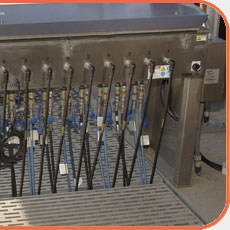Powerful ultraviolet lights are used to disinfect wastewater.

Underwater banks of UV lights are controlled through an above-ground panel
light helps clean wastewater
One of the last processes that reclaimed wastewater undergoes uses a very simple process to disinfect the water. It is simply made to flow across a bank of ultraviolet (UV) light-emitting tubes to be disinfected.
Wastewater at the City of Mason’s new Water Reclamation Plant (WRP) is held in large still-water tanks near the end of its biological treatment process. In these final clarifiers, the solids settle to the bottom of the tank and clarified water flows over the top. The UV disinfection destroys any harmful bacteria and pathogens remaining in the water before discharging it back into the environment.
UV technology replaces chlorination, which historically was used by most wastewater treatment plants for effluent disinfection. There are a number of advantages to UV disinfection compared with chlorination:
- It reduces the risk to operators as compared with the potential hazards from chlorine gas.
- It is easy to operate.
- It is cheaper to operate.
- It eliminates chlorine output to the receiving stream and the necessity to dechlorinate the water. Chlorine, even in very small amounts, is extremely harmful to aquatic life.
At the WRP, plant effluent is exposed to ultraviolet light that is generated by banks of long tubular bulbs in two concrete channels. The level of effluent in the channels is controlled so that the bulbs are always submerged, regardless of the rate of flow through the plant.
The UV system is set up to automatically adjust the intensity of the bulbs according to the flow leaving the plant. It works similar to a dimmer switch in your home, but is done automatically. The advantage of flow pacing is a reduction in power consumption, saving on monthly utility bills. The disinfected effluent is sampled and analyzed to verify that harmful organisms are being destroyed.
From the UV channels, the flow passes through a large trough and over an open cascade, a series of dams across the channel. This allows the discharged water to absorb additional oxygen before entering a 48-inch diameter pipe that conveys it to the creek.
At this point, the wastewater entering the plant has now been “reclaimed”, or cleaned and processed to where it is safe to be returned to the environment or reused.
